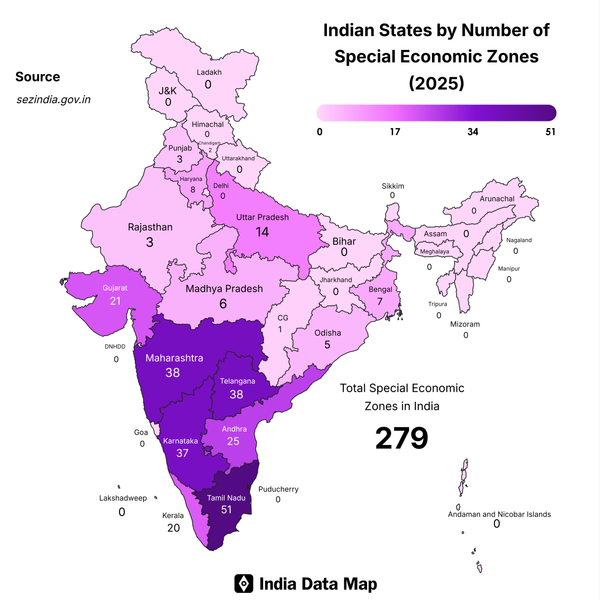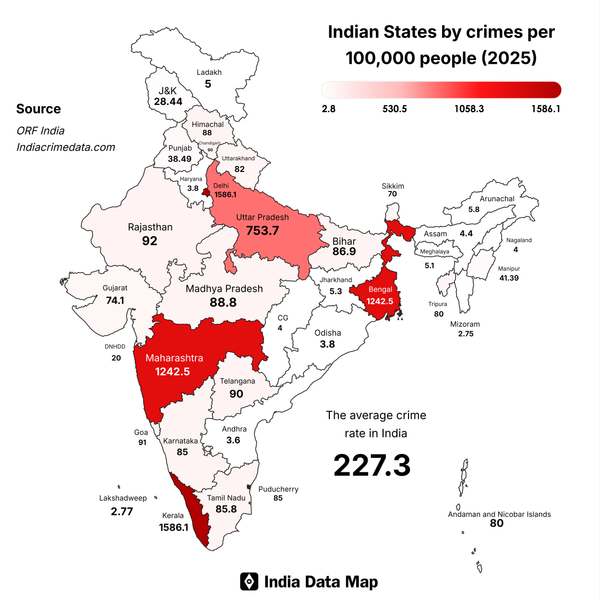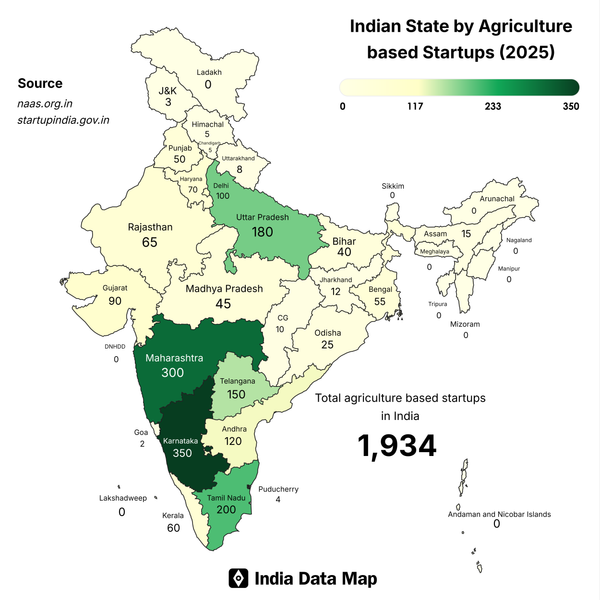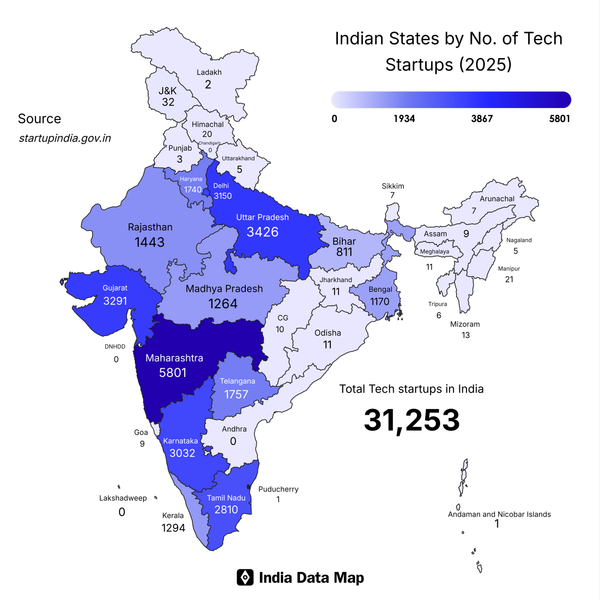Map: Indian States by Available Industrial Land (2025)
Explore India's industrial land distribution: Maharashtra leads with 25,000 ha, followed by Gujarat and Tamil Nadu. Discover key insights and state-wise rankings.
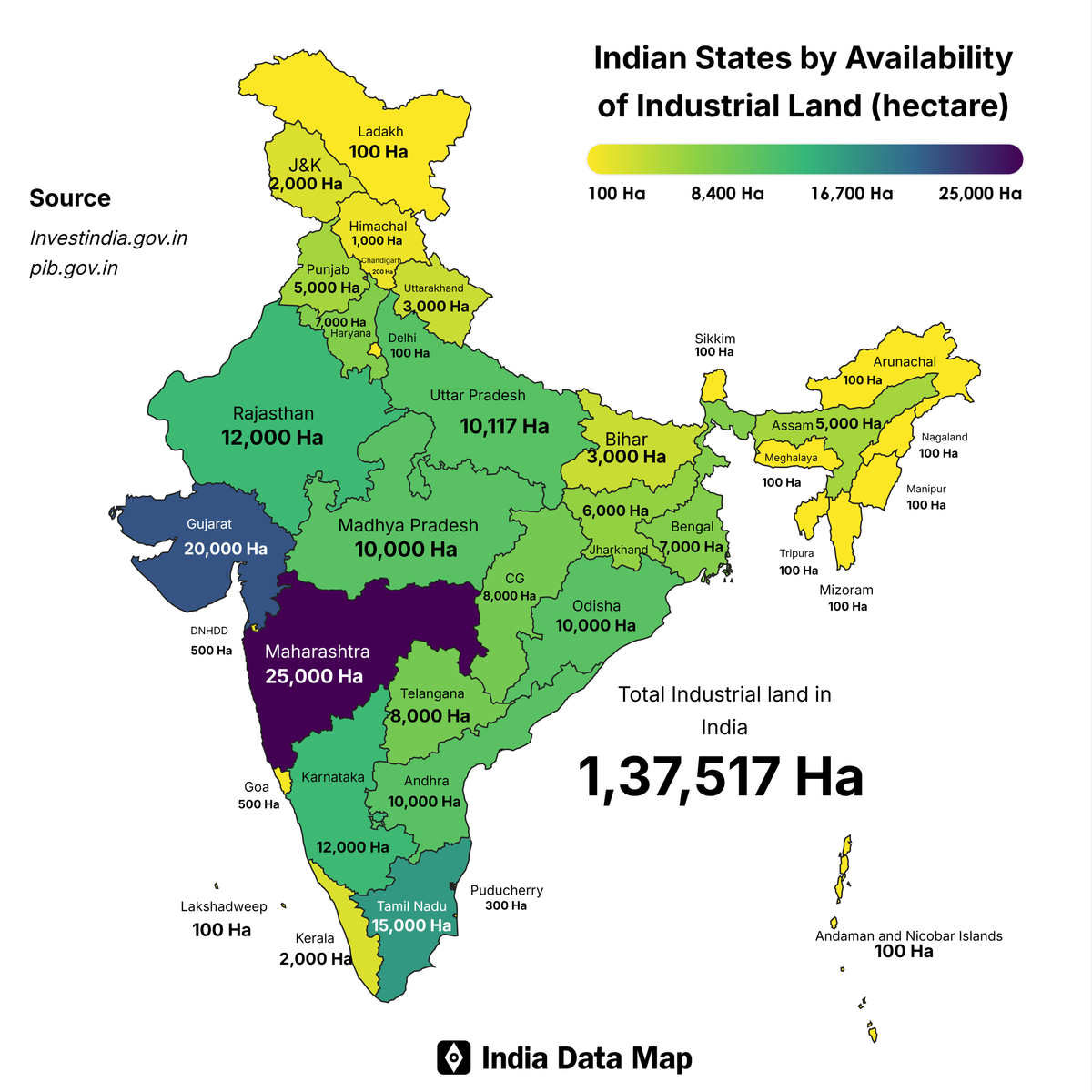
India's industrial landscape presents a dynamic tapestry, influenced by its varied geography, resources, and economic policies.
According to recent data, there are 137,517 hectares of industrial land available across its states and Union Territories (UTs), positioning India as a global manufacturing hub.
This blog post delves into the state-wise distribution of industrial land, emphasizing key facts and fascinating observations that uncover the country's industrial potential.
| Rank | State/UT | Available Land (ha) |
|---|---|---|
| 1 | Maharashtra | 25000 |
| 2 | Gujarat | 20000 |
| 3 | Tamil Nadu | 15000 |
| 4 | Karnataka | 12000 |
| 4 | Rajasthan | 12000 |
| 5 | Andhra Pradesh | 10000 |
| 5 | Madhya Pradesh | 10000 |
| 5 | Odisha | 10000 |
| 6 | Uttar Pradesh | 10117 |
| 7 | Telangana | 8000 |
| 7 | Chhattisgarh | 8000 |
| 8 | Haryana | 7000 |
| 8 | West Bengal | 7000 |
| 9 | Jharkhand | 6000 |
| 10 | Assam | 5000 |
| 10 | Punjab | 5000 |
| 11 | Bihar | 3000 |
| 11 | Uttarakhand | 3000 |
| 12 | Kerala | 2000 |
| 12 | Jammu & Kashmir | 2000 |
| 13 | Himachal Pradesh | 1000 |
| 14 | Goa | 500 |
| 14 | Dadra & Nagar Haveli and Daman & Diu | 500 |
| 15 | Puducherry | 300 |
| 16 | Chandigarh | 200 |
| 17 | Arunachal Pradesh | 100 |
| 17 | Manipur | 100 |
| 17 | Meghalaya | 100 |
| 17 | Mizoram | 100 |
| 17 | Nagaland | 100 |
| 17 | Sikkim | 100 |
| 17 | Andaman & Nicobar Islands | 100 |
| 17 | Delhi | 100 |
| 17 | Ladakh | 100 |
| 17 | Lakshadweep | 100 |
Maharashtra at the Forefront
Leading the way, Maharashtra boasts an impressive 25,000 hectares of industrial land, showcasing its position as India’s economic powerhouse.
With industrial centers such as Mumbai and Pune, the state enjoys strong infrastructure, port access, and a vibrant ecosystem for IT, automobiles, and textiles.
This dominance highlights the concentration of industrial activity in western India, which represents a substantial portion of the country’s manufacturing output.
Gujarat and Tamil Nadu: Strong Competitors
Gujarat, with 20,000 hectares, and Tamil Nadu, with 15,000 hectares, are close behind. Gujarat’s extensive coastline and well-established Gujarat Industrial Development Corporation (GIDC) parks attract industries in chemicals, petrochemicals, and gems & jewelry.
Tamil Nadu, known for its industrial corridors and skilled labor force, excels in the fields of automobiles, textiles, and IT.
Collectively, these three states—Maharashtra, Gujarat, and Tamil Nadu—constitute over 40% of India’s total industrial land, underscoring a concentration of opportunities in the southern and western regions.
The Middle Tier: Karnataka, Rajasthan, and Beyond
Karnataka and Rajasthan, each covering 12,000 hectares, are tied for fourth position.
The strength of Karnataka is attributed to its IT and aerospace sectors located in Bengaluru, whereas Rajasthan capitalizes on its mineral resources and solar energy capabilities through the Rajasthan State Industrial Development and Investment Corporation (RIICO) parks.
Additionally, states such as Andhra Pradesh, Madhya Pradesh, and Odisha, each encompassing 10,000 hectares, constitute a strong middle tier, propelled by coastal connectivity, mineral resources, and proactive industrial policies.
Uttar Pradesh, with an area of 10,117 hectares, distinguishes itself through its transparent e-auction system implemented by the Uttar Pradesh State Industrial Development Authority (UPSIDA), indicating its growing industrial aspirations.
Smaller States and UTs: Limited but Unique
At the lower end of the spectrum, states including Arunachal Pradesh, Manipur, Meghalaya, Mizoram, Nagaland, Sikkim, along with Union Territories such as Andaman & Nicobar Islands, Ladakh, and Lakshadweep, each possess approximately 100 hectares.
These areas encounter challenges such as hilly landscapes, ecological sensitivity, or isolation, which restrict the establishment of large-scale industrial operations. Nevertheless, they present unique opportunities in sectors like agro-based industries, handicrafts, and tourism.
For example, Sikkim’s emphasis on organic farming and pharmaceuticals is in line with its environmentally conscious policies, while Lakshadweep’s potential is found in fisheries and coir.
Key Insights
Regional Disparities: The western and southern states, namely Maharashtra, Gujarat, Tamil Nadu, and Karnataka, collectively account for 64,000 hectares, showcasing superior infrastructure and connectivity.
In contrast, the northeastern states and smaller Union Territories together provide less than 1,000 hectares, limited by geographical and logistical challenges.
Industrial Diversity: States with extensive land resources support a variety of industries, ranging from information technology and automobiles in Maharashtra and Tamil Nadu to mining and steel production in Odisha and Jharkhand.
Conversely, smaller states concentrate on niche sectors, such as hydropower in Himachal Pradesh and rubber cultivation in Tripura.
Policy Impact: States that implement proactive policies, such as Uttar Pradesh’s e-auction system and Odisha’s GIS-based GO PLUS platform, are more effectively positioned to attract investors, even if their land resources are not the most extensive.
Untapped Potential: The Northeast region, with limited land availability (for instance, Assam has 5,000 hectares), is gaining attention through connectivity projects like the Northeast Corridor, which has the potential to enhance agro-based and handicraft industries.
Conclusion
The distribution of industrial land in India reveals both opportunities and challenges. While Maharashtra, Gujarat, and Tamil Nadu excel in terms of scale and infrastructure, smaller states and Union Territories present unique specialized opportunities.
With a total of 137,517 hectares available across the country, India’s industrial land bank is a vital resource for fulfilling its manufacturing goals.
As states advance in digitizing land allocation (for example, through the India Industrial Land Bank portal) and enhancing connectivity, the upcoming decade may witness a more equitable distribution of industrial development, unlocking prospects throughout the nation.

